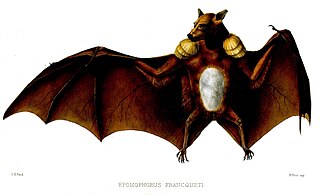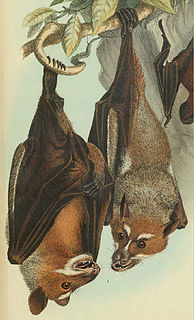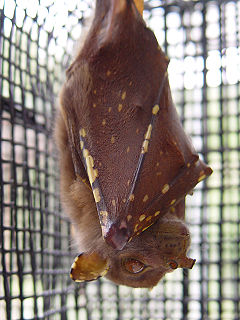
Megabats constitute the family Pteropodidae of the order Chiroptera (bats). They are also called fruit bats, Old World fruit bats, or—especially the genera Acerodon and Pteropus—flying foxes. They are the only member of the superfamily Pteropodoidea, which is one of two superfamilies in the suborder Yinpterochiroptera. Internal divisions of Pteropodidae have varied since subfamilies were first proposed in 1917. From three subfamilies in the 1917 classification, six are now recognized, along with various tribes. As of 2018, 197 species of megabat had been described.

The great stripe-faced bat or stripe-faced vampire bat is a bat species from South and Central America, where it is found from southern Mexico to Bolivia and northwestern Brazil, as well as on Trinidad. The great stripe-faced bat is a frugivore. It is one of two species within the genus Vampyrodes the other being Vampyrodes major.

Dobsonia is a genus of megabat in the family Pteropodidae. It contains the following 13 species:

Epomophorus is a genus of bat in the family Pteropodidae. They have a distribution throughout Africa.

Epomops is a genus of bat in the family Pteropodidae. It contains the following species:

Harpyionycteris is a genus of megabat in the family Pteropodidae. It contains the following species:

Melonycteris is a genus of megabat in the family Pteropodidae. Members are found in the Solomon Islands or in the case of the black-bellied fruit bat, in Papua New Guinea.
Micropteropus is a genus of bat in the family Pteropodidae. It contains the following species:

Myonycteris is a genus of bat in the family Pteropodidae.

The demonic tube-nosed fruit bat is a species of bat in the family Pteropodidae. It is endemic to Papua New Guinea. The holotype specimen was collected in 1979 on New Ireland, in the Bismarck Archipelago. It was described as a new species in 1983. The range of the species may extend to other islands, however the extent of the range is not presently known.

Ptenochirus is a genus of bat in the family Pteropodidae. It contains the following species:

The Wallace's or Sulawesi stripe-faced fruit bat is a species of megabat in the family Pteropodidae. It is endemic to Sulawesi and the nearby Togian Islands of Indonesia. Cave paintings resembling these bats have been found in Australia, where bats of this kind are not otherwise known.
The Mindoro stripe-faced fruit bat, nicknamed the "flying fox" for its foxlike face, is a species of large megabat that is endemic to the island of Mindoro. The Mindoro stripe-faced fruit bat ranked sixth in the top ten species of 2008, selected by the International Institute for Species Exploration.

Pteralopex is a genus of large megabats in the family Pteropodidae. Species in this genus are commonly known as "monkey-faced bats". They are restricted to Solomon Islands rain forests in Melanesia, and all species are seriously threatened, being rated as either endangered or critically endangered by IUCN. Two species, P. taki and P. flanneryi, have been described since 2000.

Eidolon is a genus of megabats in the family Pteropodidae. It contains two species:

Nyctimene is a genus of bats in the Pteropodidae family. Commonly known as tube-nosed fruit bats, they are found in the central Philippines, eastern Indonesia, Papua New Guinea and the north-east coast of Australia.

The steadfast tube-nosed fruit bat is a species of megabat in the family Pteropodidae found in West Papua, Indonesia, and Papua New Guinea.
Paranyctimene is a genus of bats in the family Pteropodidae. They are distributed in Indonesia















